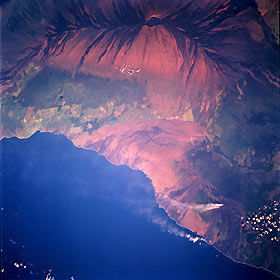
Enregistrez gratuitement cette image
en 800 pixels pour usage maquette
(click droit, Enregistrer l'image sous...)
|
|
Réf : T01505
Thème :
Terre vue de l'espace - Volcans (181 images)
Titre : Kilauea and Mokuaweoweo Craters, Hawaii, U.S.A. September 1993
Description : (La description de cette image n'existe qu'en anglais)
This extraordinary photograph shows the summit and southeast portion of Mauna Loa Volcano, the largest mountain in the world in cubic content, and two of its most active volcanic craters—Mokuaweoweo Crater, the dark pit near the summit of Mauna Loa, and Kilauea Crater (large circular feature west of the steam pall) on the southeastern flank of Mauna Loa. Mauna Loa is a massive shield volcano whose summit rises 13 680 feet (4170 meters) above sea level. The volcano’s lava is extremely fluid because of its low content of silica and gases and its very high temperature. During eruption, the lava can flow more than 20 miles (32 kilometers) before it cools and hardens (old flows visible in the photograph). Spreading out in broad sheets as if it were melted tar, layers of lava have accumulated over millions of years to form Mauna Loa’s domal profile. Near the summit of Mauna Loa is Mokuaweoweo Crater, with a depth of nearly 800 feet (245 meters), a length of 3 miles (5 kilometers), and a width of 2 miles (3 kilometers). During active periods (the last in the spring of 1984), lava streams flow from the crater down the slopes of the volcano. Together, Kilauea Crater and smaller Halemaumau Crater (not discernible in photograph), at an elevation of 4090 feet (1247 meters) and a circumference of 8 miles (13 kilometers), are surrounded by a wall of volcanic rock 200 to 500 feet (61 to 153 meters) high. A string of craters extends eastward along a rift zone, site of the current eruption (steam pall). Steam is blowing southwest from the main crater lake, Puu Oo, now filled with lava, which travels down the mountainside to the ocean through lava tubes and enters the ocean (steam pall) along the eastern side of the newly built (l992) Kamoamoa Delta. The dark lava flows, which covered roads and subdivisions during the eruptions between 1983 and 1990, are visible east of the steam palls. The clarity of this photograph allows easy identification of the Olaa Rain Forest (dark green) north of the Kilauea crater and the agricultural land along the eastern coast.
|
|

